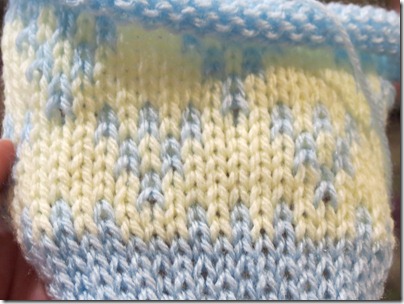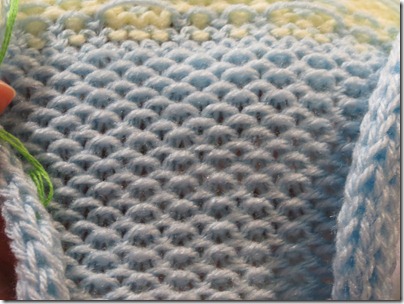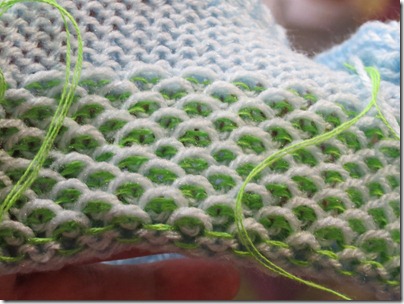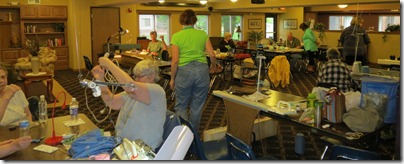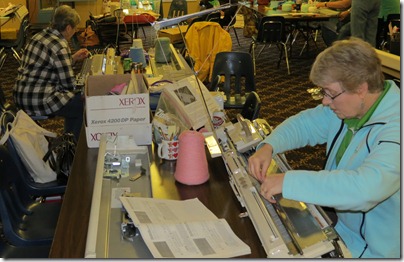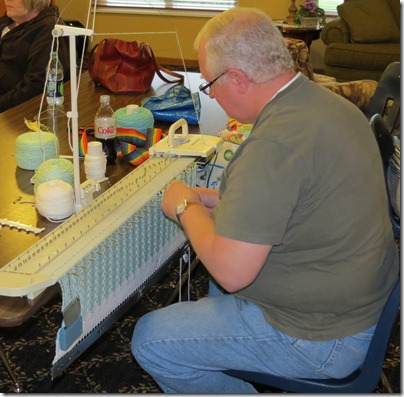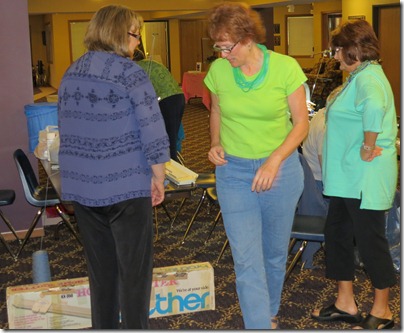Well, it looks as though somebody finally paid the water bill, as we have been having quite a bit of rain lately. This is a good thing, considering the faucet was turned off beginning in August, but I'd much rather have our precipitation come at regular intervals throughout the year, rather than all at once, or worse, none at all for lengthy periods of time. Let’s hope this means an end to our drought, but unfortunately, it also means the beginning of mosquito season.
April’s meeting had a tremendous turn-out! Thank you to all who came, and especially to our visitors. The meeting began with an ice-breaker, facilitated by Polly, in which we tossed a ball of yarn randomly around the circle of members, all while holding onto the string (to show how we’re all inter-connected), and the member who caught the yarn had to say something “interesting” about themselves. It seems machine knitters like to get out and do a lot of traveling to exotic locales! Who knew? We all do, now! Thanks, Polly!
Mary Ann gave a demonstration on different seaming techniques. It’s been said that hand-knitting is a lot of knitting with very little finishing, and machine knitting is a little knitting with a lot of finishing. That may or may not be true, but one thing is certain: when knitting on a flat-bed machine, there will be seams to sew.
Mary Ann discussed five different seaming techniques:
-
Mattress Stitch
-
Kitchener Stitch
-
Bickford Seam
-
Sew As You Go (SAYG)
-
Grafting
(Bold and purple letters below are links to video or photo demonstrations of the stitches highlighted.)
Mattress Stitch is probably the most commonly used, and easiest seaming method for knitters to learn. It is the sewing technique used to join the sides of a sweater, front to back, and is accomplished by picking up the “bar” in the middle of the stitch on one side to be sewn, then going across and picking up the corresponding “bar” in the middle of the stitch on the second side.
Kitchener Stitch is the stitch used to join the ends of knitting, rather than the sides. It was supposedly invented by a Lord Kitchener, a British field marshal, who wanted his men to have a more comfortable seam in their socks, rather than the one used at the time, which would rub uncomfortably across the toes. It is the stitch knitters still use to this day to seam the toes of socks, and isn’t as daunting to learn as it “seams” (pun intended). It is easiest to accomplish this seam from the purl side of the knitting, rather than the knit side. One simply picks up a purl bump from one side, goes through the corresponding purl bump on the other, then comes back through the neighboring purl bump on the second side, and back through the original purl bump on the first side. After this one goes through the back of the neighboring stitch to the first bump, and across to the second stitch on the other side, etc.. An easy mnemonic to remember is “Go across the street to visit, then go through the neighbor’s back door. Go home again and go through the neighbor’s back door before crossing the street again.”
The
Bickford Seam can be used as an alternative to Mattress Stitch when you want a flat,
almost-invisible seam. (Mattress Stitch, while completely invisible from the knit side, is not flat, and is obvious from the purl side.) When executed correctly, it looks identical to the SAYG seam (see below). There are a number of
different methods to accomplish this, but the result is the
same. On the edges of all knitting one will see a loop and a bump. One would insert the needle into the loop on one side, through the corresponding loop on the other side, then back through the knot above the second loop, and into the knot above the first loop. Loop to loop, knot to knot. It can also be done loop to knot, loop to knot. Do not pull the stitches tightly together, as this deforms the pieces you are trying to seam!
Sew As You Go (SAYG) is a method of joining seams right on the machine. It can be used for a number of different projects, such as joining different color blocks, or for joining the side seams of
socks that are made on the flat-bed machine without a ribber, allowing you to make the whole sock in one piece, and without the need to seam. (This is how you would make a sock (or
slipper) on the Bond machines, which don’t have ribbers available for them.) It is accomplished by picking up the bottom loop edge stitch from a finished piece and placing it on the first needle to be knit with the first row of the next piece. Knit 2 rows. Pick up the next loop, and hang it on the first needle, knit 2 rows, etc.. The pieces will be joined together automatically. You can also try it by hanging the knots of the finished piece to see if that hides the seam a little better, or experiment with picking up both loops of the stitch, instead of the outer loop.
Grafting on the machine is an easy way for joining Kitchener seams without the need for waste yarn, and minimizes the chance for errors in picking up the wrong stitches. It’s also the easiest method for doing Kitchener Stitch from the knit side, rather than the purl side because you can easily see which stitches to pick up. Finally, it can be used when knitting knit side to knit side, purl side to purl side, or, if desired, knit side to purl side because you only need to keep track of the stitches that are hanging on the needles, rather than digging for the right stitches through waste yarn. Give it a try!
